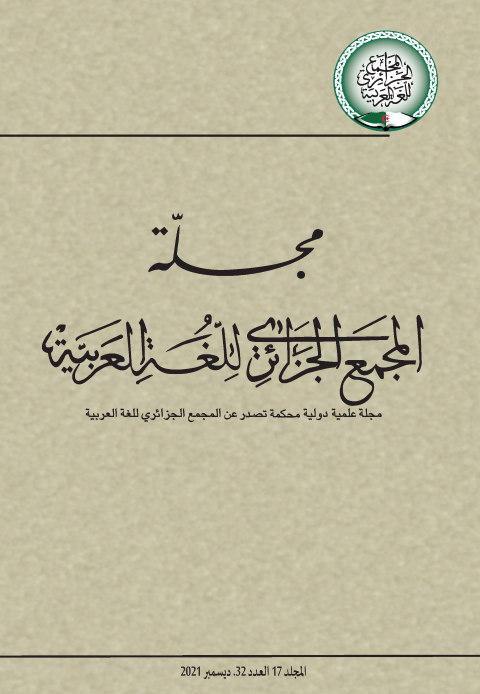عود الضمير: هاء الضمير الغائب وأثرها في توجيه معاني القرآن عند الإمام ابن جرير الطبري في تفسيره. -سورة ءال عمران، والنساء، والمائدة. أنموذجا- تابع
DOI:
https://doi.org/10.70443/jaaal.v17i2.24الكلمات المفتاحية:
هاء الضمير الغائب و أثرها، توجيه معاني القرآن، ابن جرير الطبري في تفسيره، سورة ءال عمران، النساء، المائدة أنموذجا.الملخص
لقد اعتنى العلماء-رحمهم الله- قديما و حديثا بالدراسات القرآنية، سواء فيما يتعلق بالجانب البلاغي أو النحوي وغيرها، وإن مسألة عود الضمير في القرآن الكريم على وجه العموم و"هاء" الضمير الغائب على وجه الخصوص، من بين أهم المسائل التي لاقت عناية كبيرة لدى العلماء والباحثين، إذ لا يفتؤن في بيان عائد الضمير لِما له من أهمية في تحديد المعاني المختلفة إن كان للضمير يحتمل أكثر من عائدٍ، ولكن تبقى هذه الدراسات في تطور مستمر، كما أنَّ بعضها تحتاج إلى لمّ شملها، فجاءت هذه الدراسة في جمع شتات هذا الموضوع، مركزا على تفسير "جامع البيان في تأويل القرآن" للإمام ابن جرير الطبري في توجيه معاني عائد الضمير، مع ذكر أقوال أهل العلم من المفسرين، كابن عطية، وأبي حيان، وغيرهما، مع مناقشة الأقوال دون توسعٍ، مع ذكر رأي الباحث في كل مسألة معروضة في هذا البحث، وذلك من خلال نماذج مختارة من سورة ءال عمران، والنساء، والمائدة.
التنزيلات
المراجع
القرآن الكريم، برواية حفص عن عاصم.
al-Qurʼān al-Karīm, bi-riwāyat Ḥafṣ ʻan ʻĀṣim.
أضواء البيان في إيضاح القرآن بالقرآن، محمد الأمين الشنقيطي، دار الفكر للطباعة والنشر والتوزيع، بيروت، لبنان، 1995م
Aḍwāʼ al-Bayān fī Īḍāḥ al-Qurʼān bi-al-Qurʼān, Muḥammad al-Amīn al-Shinqīṭī, Dār al-Fikr lil-Ṭibāʻah wa-al-Nashr wa-al-Tawzīʻ, Bayrūt, Lubnān, 1995m
البحر المحيط في التفسير، لأبي حيان، تحقيق: صدقي محمد جميل، دار الفكر، بيروت، 1420 هـ
al-Baḥr al-muḥīṭ fī al-tafsīr, li-Abī Ḥayyān, taḥqīq : Ṣidqī Muḥammad Jamīl, Dār al-Fikr, Bayrūt, 1420 H
التبيان في إعراب القرآن، لأبي البقاء عبد الله العكبري، تحقيق: علي محمد البجاوي.
al-Tibyān fī iʻrāb al-Qurʼān, li-Abī al-Baqāʼ ʻAbd Allāh al-ʻUkbarī, taḥqīq : ʻAlī Muḥammad al-Bajāwī.
جامع البيان في تأويل القرآن، لأبي جعفر الطبري، تحقيق: أحمد محمد شاكر، مكتبة ابن تيمية، القاهرة، الطبعة الثانية.
Jāmiʻ al-Bayān fī Taʼwīl al-Qurʼān, li-Abī Jaʻfar al-Ṭabarī, taḥqīq : Aḥmad Muḥammad Shākir, Maktabat Ibn Taymīyah, al-Qāhirah, al-Ṭabʻah al-thāniyah.
الدر المصون في علوم الكتاب المكنون، لأبي العباس أحمد بن يوسف، المعروف بالسمين الحلبي، تحقيق: الدكتور أحمد محمد الخراط، دار القلم، دمشق.
al-Durr al-maṣūn fī ʻulūm al-Kitāb al-maknūn, li-Abī al-ʻAbbās Aḥmad ibn Yūsuf, al-maʻrūf bi-al-Samīn al-Ḥalabī, taḥqīq : al-Duktūr Aḥmad Muḥammad al-Kharrāṭ, Dār al-Qalam, Dimashq.
زاد المسير في علم التفسير، لأبي الفرج جمال الدين، المعروف بابن الجوزي، تحقيق: عبد الرزاق المهدي، دار الكتاب العربي، بيروت، الطبعة الأولى، 1422 هـ.
Zād al-Musayyar fī ʻilm al-tafsīr, li-Abī al-Faraj Jamāl al-Dīn, al-maʻrūf bi-Ibn al-Jawzī, taḥqīq : ʻAbd al-Razzāq al-Mahdī, Dār al-Kitāb al-ʻArabī, Bayrūt, al-Ṭabʻah al-ūlá, 1422 H.
المحرر الوجيز في تفسير الكتاب العزيز، لابن عطية، تحقيق: عبد السلام عبد الشافي محمد، دار الكتب العلمية، بيروت، الطبعة الأولى، 1422 هـ.
al-Muḥarrir al-Wajīz fī tafsīr al-Kitāb al-ʻAzīz, li-Ibn ʻAṭīyah, taḥqīq : ʻAbd al-Salām ʻAbd al-Shāfī Muḥammad, Dār al-Kutub al-ʻIlmīyah, Bayrūt, al-Ṭabʻah al-ūlá, 1422 H
مفاتيح الغيب، فخر الدين الرازي، دار إحياء التراث العربي، بيروت، الطبعة الثالثة، 1420 هـ.
Mafātīḥ al-ghayb, Fakhr al-Dīn al-Rāzī, Dār Iḥyāʼ al-Turāth al-ʻArabī, Bayrūt, al-Ṭabʻah al-thālithah, 1420 H.
التنزيلات
منشور
إصدار
القسم
الرخصة
الحقوق الفكرية (c) 2021 المؤلفون

هذا العمل مرخص بموجب Creative Commons Attribution-NonCommercial 4.0 International License.













 مجلة المجمع الجزائري للغة العربية تصدر عن
مجلة المجمع الجزائري للغة العربية تصدر عن